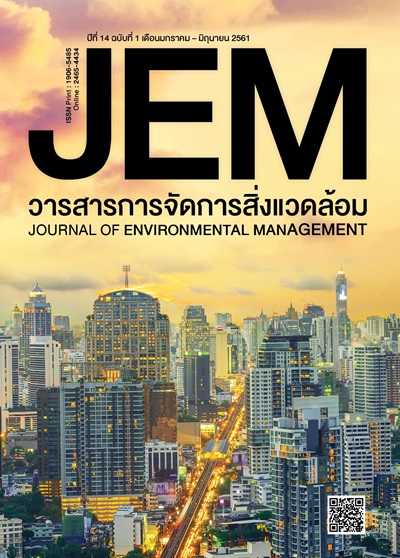การขยายตัวของประชากรเมืองกับสถานการณ์การตายด้วยโรคไม่ติดต่อ: การศึกษาทุติยวิเคราะห์ EXPANSION OF THE URBAN POPULATION AND NON-COMMUNICABLE DISEASES SITUATION: A SECONDARY DATA ANALYSIS STUDY
คำสำคัญ:
ภาวะโรคไม่ติดต่อ, ระบบอาหารชุมชน, กระบวนการเป็นเมืองบทคัดย่อ
บทความนี้เป็นการเชื่อมโยงสถานการณ์การขยายตัวของประชากรเมืองกับภาวะการตายของประชากรโลกด้วยโรคไม่ติดต่อ พร้อมทั้งค้นหาปัจจัยของความสัมพันธ์ระหว่างประชากรเมืองกับอัตราการตายด้วยโรคไม่ติดต่อ และเสนอแนวทางการแก้ไขอัตราการตายด้วยโรคไม่ติดต่อที่แตกต่างกันในแต่ละภูมิภาค ซึ่งยุโรปมีอัตราการตายเฉลี่ยสูงที่สุด (90.4%) รองลงมาคือเอเชีย อเมริกาเหนือ อเมริกาใต้ และแอฟริกา มีอัตราการตายเฉลี่ยที่ร้อยละ 73.8, 72.6, 70.1 และ 37.7 ตามลำดับ การวิเคราะห์ทางสถิติพบว่าอัตราการตายด้วยโรคไม่ติดต่อของประชากรโลกมีความสัมพันธ์กับจำนวนประชากรเมืองอย่างมีนัยสำคัญ โดยพฤติกรรมและสภาพแวดล้อมเป็นปัจจัยหลักของความสัมพันธ์ดังกล่าว พฤติกรรมที่ส่งเสริมการเกิดโรคไม่ติดต่อ คือ การกินอาหารที่ไม่เป็นประโยชน์ต่อสุขภาพ การดื่มแอลกอฮอล์ การสูบบุหรี่ และการขาดการออกกำลังกาย ในขณะที่สภาพแวดล้อมเมืองส่งผลให้เกิดการเปลี่ยนแปลงพฤติกรรมด้านระบบอาหารของชุมชนจากการเตรียมอาหารในครัวเรือนเป็นการพึ่งพาอาหารจากภายนอก สังคมเมืองต้องการความรวดเร็วและสะดวกจึงนิยมอาหารแปรรูปมากกว่าอาหารสด แนวทางการรักษาสุขภาพให้ห่างไกลจากโรคไม่ติดต่อควรเน้นการปรับเปลี่ยนพฤติกรรมในการกินอาหารที่มีใยอาหารลดอาหารที่มีไขมันอิ่มตัวสูง และออกกำลังกายอย่างสม่ำเสมอ สร้างสภาพแวดล้อมเมืองที่ส่งเสริมและเชื้อชวนให้ประชากรมีการออกกำลังกายอย่างเหมาะสม
References
Djurfeldt, Agnes A. (2015). Urbanization and linkages to smallholder farming in sub-SaharanAfrica: Implications for food security. Global Food Security, 4, 1-7.
Elmqvist, T., Redman, C. L., Barthel, S., and Costanza, R. (2013). History of urbanization and the
missing ecology. In T. Elmqvist, M. Fragkias, J. Goodness, B. Güneralp, P. Marcotullio,
R. McDonald, S. Parnell, M. Schewenius, M. Sendstad, K. Seto, and C. Wilkinson (Eds.),
Urbanization biodiversity and ecosystem services: Challenges and opportunities
(pp. 13-30). New York, London: Springer.
Guthrie, J. F., Lin, B.-H., Frazao, E., and Nutr, J. (2002). Role of food prepared away from home in the American diet, 1977-78 versus 1994-96: changes and consequences. Journal of Nutrition Education and Behavior, 34, 140–150.
Lim, S. (2007). Global warming: The truth you must know [In Thai]. Bangkok: Freemild publishing.
Ma, H., Huang, J., Fuller, F., and Rozelle, S., (2006). Getting rich and eating out: consumption of food away from home in urban China. Canadian Journal of Agricultural Economics, 54, 101–119.
Nawarat, L. (1999a). The concept of livable city: Part 2 Healthy people healthy city and community [In Thai]. Retrieved April 5, 2017, from https://www.anamai.moph.go.th/ewtadmin/ ewt/advisor/main.php?filename=cities02
Nawarat, L. (1999b). The concept of livable city: Part 3 Who make city healthy? [In Thai]. Retrieved April 5, 2017, from https://www.anamai.moph.go.th/ewtadmin/ewt/advisor/main.php?filename=cities03
NHS choices. (2016). Causes of obesity. Retrieved June 22, 2017, from https://www.nhs.uk/Conditions/Obesity/Pages/ Causes.aspx
Ratrasarn, C. (2013). Diabetes epidemic and its impacts in Thailand [In Thai]. Retrieved April 5,2017, from https://www.dmthai.org/sites/default/files/briefingbook_38.pdf
Secretariat of the Convention on Biological Diversity. (2012). Cities and Biodiversity Outlook. RetrievedApril 5, 2017, from https://www.cbd.int/doc/health/cbo-action-policy-en.pdf
Seto Karen C. and Ramankutty, N. (2016). Hidden linkages between urbanization and food systems.Science, 352(6288), 943-945.
Seto, Karen C., Susan P., and Elmqvist, T. (2013). A global outlook on urbanization. In T. Elmqvist,M. Fragkias, J. Goodness, B. Güneralp, P. Marcotullio, R. McDonald, S. Parnell,M. Schewenius, M. Sendstad, K. Seto, C. Wilkinson (Eds.), Urbanization biodiversity and ecosystem services: Challenges and opportunities (pp. 1-12). New York, London:Springer.
Silpasuwarn, P., Vivatwongkasem, C., Kittipichai, W., Aummaneekul, N., Satitvipawee, P., Sujiraratn,D., Chumchai, P., Hanklang, S. (2013). Data analysis and overall outcome in observation,protection, and control of the related departments in national level 2008-2012.[In Thai]. Retrieved April 7, 2017, from https://www.thaincd.com/document/file/download/knowledge/NCD-ebook211013.pdf
Tilman, D. and Clark, M. (2014). Global diets link environmental sustainability and human health.Nature, 515, 518–522.
United Nations. (2014). World urbanization prospects: The 2014 revision. New York: United Nations.
Wibuloutai, J. (2000). Health risk assessment in environmental health [In Thai]. Journal of Environmental Management, 6(2), 133-144.
World Health Organization. (2011a). Global health observatory. Retrieved May 2, 2017, from https://www.who.int/gho/ncd/en/index.html
World Health Organization. (2011b). New WHO report. Retrieved April 27, 2017, from https://www.who.int/mediacentre/news/releases/2011/ncds_20110427/en/index.html.
World Health Organization. (2013). Draft action plan for the prevention and control of non-communicablediseases 2013-2020. Retrieved April 27, 2017, from https://apps.who.int/gb/ebwha/pdf_files/WHA66/A66_9-en.pdf
World Health Organization. (2014a). Non communicable Diseases (NCD) Country Profiles. Retrieved January 12, 2017, from https://www.who.int/nmh/countries/tha_en.pdf
World Health Organization. (2014b). Global statue report on non-communicable diseases 2014:Attaining the nine non-communicable diseases target; a shared responsibility. Switzerland:WHO press.


